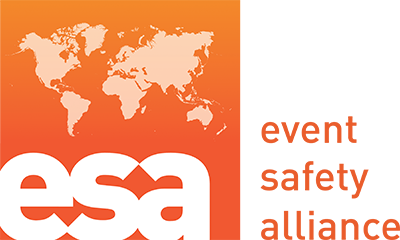Update on Event Safety Guide Revision Process
Greetings Ladies and Gentlemen,
My name is Don Cooper and I am the Executive Director of the Event Safety Alliance® (ESA). I am writing on behalf of the ESA Board and its Chairman, Jim Digby, to thank you for generously offering to contribute to the Second Edition of the Event Safety Guide. This note is intended to describe both the planned revision process and how you can contribute your much needed, and much appreciated, expertise.
I’ll start with some very good news. The Entertainment Services and Technology Association (ESTA; www.esta.org) has been a supportive partner of ESA and its safety mission since ESA’s inception in 2012. ESTA’s Technical Standards Program (TSP) has accepted ESA’s application to establish a new Event Safety Working Group that will work to transition the current Guide into a number of ANSI standards (American National Standards Institute; www.ansi.org). You can learn more about the TSP and its current Working Groups here: http://tsp.esta.org/.
What this means is that the process of revising the current Guide would be turned over to a new ESTA TSP Working Group that would recruit volunteers (like you) to revise it. If everything works out as planned, ESTA will be in a position to freely distribute these new standards just like they do their other published documents, all of which can be found here: http://tsp.esta.org/tsp/documents/published_docs.php.
The documents that result from this process would be widely accepted, national standards for many aspects of live event operations and planning. According to the TSP, “the ANSI designation on a standard is universally recognized as a mark of technical diligence and commercial impartiality” and the ESTA TSP is the “…only ANSI-accredited standards program dedicated to the needs of the entertainment technology industry” (tsp.esta.org). Turning the current document into a series of ANSI standards would definitely increase the value of the information to the industry, which is exactly why ESA is choosing this way forward.
So, with the described approach, how exactly do you contribute? Well, the short answer is that you submit an application to become a member of the Event Safety Working Group (found here), and here is how the TSP describes the process of joining (http://tsp.esta.org/tsp/working_groups/index.html):
Membership in a working group is available to any party who has a material interest in the topics covered by that group and knowledge relevant to those topics. There are two basic types of membership: voting and observer. To be a voting member you must be able to support the work of the group by attending meetings on a regular basis (generally four per year) and responding to letter ballots and other correspondence. Observer status is non-voting and attendance at meetings is not required. You do not need to be a member of ESTA to participate in a working group. Members need to have access to email, because all documents are distributed by email only. There is a $100 a year participation fee to ESAT for TSP membership. This is a flat rate, regardless of voting status or the number of working groups in which a person is a participant.
If you cannot afford the participation fee, the TSP Participation Fee Donor Fund may be able to assist you. Please contact TSP staff at standards@esta.org and tell us why the participation fee prevents you from participating.
If you would like to become a member of an existing Working Group you must complete an application [attached] and send it to the ESTA standards office at the address shown on the form. Your application is subject to approval by the Working Group. Send it at least two weeks before the working group meeting at which you would like it to be considered. Explanations of the application form’s voting status classifications and interest categories can be found on the second page of the form. Contact the Technical Standards Manager (erin.grabe@esta.org) if you need a hardcopy of the application mailed to you.
Since the Working Group is just being established, it is likely that virtually all of the initial applications will be accepted. Our current plan is to hold the first meeting of the Event Safety Working Group at the LDI Conference in Las Vegas on Friday, October 21, 2016.
We know most people cannot attend four or more meetings per year at various locations around the country, so ESTA TSP uses conferencing technology (WebEx) so Working Group members can attend remotely. More information on this option will be made available upon acceptance to the Working Group.
The Event Safety Alliance needs your help to make this process work. It will take all of us to transform what so many have worked so hard to develop into something even better. Please help us by becoming a member of the Event Safety Working Group and contributing your expertise. With your help, we will make great strides toward improving safety at live events.
In summary, here is what is happening and how you can participate:
- The revision of the ESA’s Event Safety Guide will be managed by a new ESTA TSP Event Safety Working Group.
- Participation in this working group will be the only way to help create the Second Edition of the Event Safety Guide.
- To participate in this revision process, one must submit a Working Group application to ESTA TSP and pay $100 per year to ESTA. This annual fee allows you to participate in any ESTA Working Group in that year, but will require a separate application be submitted to each.
The first meeting of the Event Safety Working Group is currently scheduled on Friday, October 21, 2016, during the LDI Conference in Las Vegas.
Thank you, again, for your offer to help. Together we can significantly improve safety at live events.
Kindest Regards,
Donald C. Cooper, PhD, MBA
Executive Director
Event Safety Alliance
www.eventsafetyalliance.org
donaldcooper@eventsafetyalliance.org

